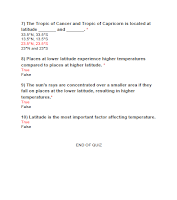Temperature generally decreases by 6.5°C for every 1000 metres increase in altitude. (note in the diagram below, the temperature at the base level 0m starts at 19.5°C, decreases to 0°C at 3000m and reaches -13°C at 5000m).
Altitude affects temperature in two ways
1) Distance from Earth's Surface
2) Density of Air
Distance from Earth's Surface
Temperature decreases with altitude because the atmosphere is mostly heated up by the earth's surface.
When the sun's solar energy enters the atmosphere, it reaches the earth's surface in the form of shortwave radiation. About 45% of the total solar energy entering is directly absorbed by the earth's surface, heating it up. The warm surface of the earth then emits heat in the form of longwave radiation.
Air that is nearer to the earth is nearer to the source of heat. Thus it absorbs more heat than air at the higher altitudes. Therefore with increasing altitude, temperature will fall.
Density of Air
Due to the force of gravity, more air molecules are nearer to the surface of the earth (refer to diagram below). As a result, air is denser at a lower altitude (nearer to earth's surface) because of gravity.
Each air molecule has the ability to trap heat. Thus, where there are more air molecules, more heat will be trapped. Denser air in the lower altitude has a greater ability to absorb heat than less dense air in the higher altitude.
 |
Density of
Air
with
Increasing Altitude
|
Click on the link below to answer the quiz to test your understanding :)
Click on the image below to check if you managed to get the correct answers to the quiz :)





